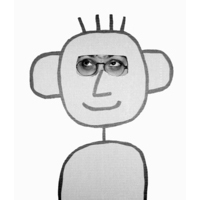TYPO Berlin 2009 – Exploring (((Typo)Graphic) Design) Space

As I mentioned in yesterday's introduction I only flew in on Thursday morning, which is why I was too late for the first two presentations. I really regretted missing out on Gerard Unger's Between Forms, an examination of letter forms for stone and textiles, inscriptions and rugs for the restored university buildings at the University of Leiden. Gerard is one of the best "quiet" presenters I know, tackling his subjects with expertise, historical sense, and deadpan wit. You're guaranteed to leave the auditorium having learned a lot, and although he rarely does more than crack a sly smile Gerard has the uncanny ability to introduce a laugh-out-loud moment in even the most in-depth exposé.
Gerard Unger © Frank Grießhammer
The other thing I really would've loved to have seen was Erik van Blokland and Paul van der Laan's workshop Type Cooking with Erik and Paul, which as far as I understood saw them applying the teaching methods based on Gerrit Noordzij's The Stroke: Theory of Writing.
Erik van Blokland & Paul van der Laan © Fontblog
After having picked up my accreditation at the press stand, I proceeded to TYPO Hall to see Space, the aptly named presentation by Joshua Davies. I was warmly greeted by type designer, graphic designer, musician, radio host, and all-round great guy Donald Beekman, whom I learned to know at TypeCon2005 when he interviewed me for Typeradio. Donald did English moderation alongside the ever-lovely Simone Wolf who took care of German moderation in TYPO Hall, replacing Clemens Schedler who was assigned TYPO Stage. TYPO Show was in the expert hands of Indra Kupferschmid and Alessio Leonardi, the designer of some of the most fun typefaces around.
Joshua Davis | SPACE

Joshua Davis © Gerhard Kassner
I don't know how the first presentations went down, but for me personally TYPO Berlin got off to a rocking start with New Yorker Joshua Davis. More than a mere designer or artist, Davis uses the term "technologist" to indicate that he creates through innovative programming using technology and computers. His mathematical-generative creation technique Dynamic Abstraction explores the technical and aesthetic boundaries of Adobe Illustrator and Flash, and stretches their possibilities to the limit. At some point in his talk he jokingly claimed Illustrator tells him "I hate you!" whenever he opens one of the generated super-dense vector art files. We have crossed a major turning point – whereas twenty years ago computers were incapable of replicating design done by hand, today the human hand is incapable of replicating design done by computer.
Every year Davis imposes a theme on himself, so when he was invited last year to give a lecture at this edition of TYPO Berlin it only made sense to work around the concept of "Space". Exploring the different meanings and iterations of the concept "space" he devised several systems to generate artwork. What made his presentation so valuable is that he showed step by step his journey from abstract concept to prototype to image generation to finished artwork. It was fascinating to observe how very simple starting points – be it experiments with rhythm and spacing between elements, kaleidoscopic images, elements moving in spherical revolutions or along Bézier paths – gradually evolved into increasingly complex compositions to eventually yield gorgeous multi-layered explosions of shape and colour.

a Better Tomorrow, kaleidoscopic artwork generated with heraldic elements (left: outlines; right: coloured-in art)
Due to its programmed origins Davis' artwork heavily relies on chance. Quick and seemingly random decisions were at the basis of endless streams of images, and Davis' role as a designer was reduced to decision making. Seeing the intermediary stages and abandoned avenues was very enlightening. The best part is that Davis readily admits that he sometimes doesn't really know what is happening, but that doesn't make the process nor the end result any less exciting. I was particularly in awe for his sense of colour and the surprising colour schemes he assembled. A high point in his presentation were his interactive exhibition pieces, where observing the audience participation was at least as interesting as the installations themselves.

Random Assistant Rovereto invited passers-by to participate by colouring in the outline artwork.
Joshua Davis gave a very spirited and energetic performance. Despite his exuberant delivery he successfully steered clear of overacting. His boyish enthusiasm was infectious, and he proved to be a consummate entertainer. This easily was one of the best presentations of the conference.
During coffee break I quickly snuck into TYPO Lab to visit fellow Typophile Florian Hardwig's Déjà vu – a Typographical Quiz. This fun and light-hearted game examined how much of the images, symbols, and letters surrounding us stick in our visual mind. Participants were given sheets of paper and pencils, and were invited to draw things from memory, ranging from logos over landmarks to typefaces and glyphs. The room was rife with sighs of concentration and victorious whispers when I had to leave halfway this session.
Florian Fischer | Form Follows Space

Florian Fisher © Gerhard Kassner
The contrast between Joshua Davis' presentation and Form Follows Space by Florian Fischer couldn't have been more dramatic. Fisher's talk dealt with the theme Space not in a graphic, but in a human and metaphysical context. It came across as a loose assembly of ideas and relied very much on audience participation. Gongs were struck, after which an exhibition panel holder was used to represent respiration, and then was sent crowdsurfing over the audience. Fischer tried to have members of the audience form the title of his talk with large cards featuring the spaces between the letters with half a letter at each side. Unfortunately this backfired quite badly and led to a long-winding and confusing episode while he desperately tried to get the cards to line up in the correct order. Then he continued with amongst others a description of his office space, space between people, sound filling space, and so on. Fischer ended with an attempt at coaxing the audience to join a singing exercise reciting the vowels of the alphabet… which yielded zero result and had him end his presentation on a disappointing low note.
Fisher's presentation was confusing and unengaging, appeared not sufficiently prepared, and seemed to go nowhere. Even with the hold-ups it still clocked in at barely half an hour. Although I felt quite sorry for the fact that nothing worked out as intended, I couldn't help myself but think of Ricky Gervais/David Brent in Episode Four of the second season of The Office, the one where he is being head-hunted by the UK's leading agency for Inspirational Business Speakers. A real shame.
Header image:Audience in TYPO Hall © Frank Grießhammer
-
 Cangji Fonts
Cangji Fonts
Brand: 仓迹字库
Area: China

-
 JT Foundry
JT Foundry
Brand: 翰字铸造
Area: Taiwan, China

-
 Handmadefont
Handmadefont
Brand:
Area: Estonia

-
·千图字体
-
 HyFont Studio
HyFont Studio
Brand: 新美字库
Area: China

-
 Minrui Type
Minrui Type
Brand: 敏锐字库
Area: China

- ·Königsblut identity
- ·Japanese Typography Writing System
- ·10 Top Romantic Fonts on Valentine's Day!
- ·Moving Hands (Helena Hauff Remix) by The Klinik, official video
- ·Chinese College Student Invents Smog Font
- ·Linotype Ad: "Linotype vs. Intertype"
- ·Hollywood Star Matt Damon Wrote Better Chinese than Chinese Stars
- ·Cher Got Sued For Font!
- ·How to sell your typefaces
- ·Ad for Hello Dummy! by Don Rickles
























